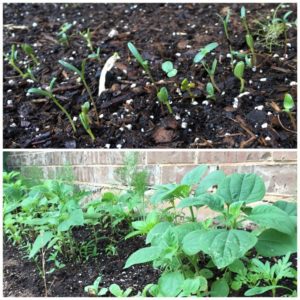
The morning air is crisp, soft with dew. The sun warms our skin, and the foliage begins to turn a deep green. Ahhhh spring is finally here, and it’s time to bring out the gardening gloves and dig into the rich soil.
Gardening can be a cathartic, therapeutic experience. It’s so rewarding to sow seeds and watch your creation bloom and mature. If you’re ready to start planting, here’s a guide to get you started.
1. Determine your garden space.
Look around your yard and identify the space you want for your garden. Keep a few things in mind while hunting for that perfect location. Is is easily accessible by the garden hose? Can I enjoy it from inside my house through a window? Do I want a shade garden or sun garden?
Next to your house or fence line, lining the sidewalk, or around a tree are all popular places for a garden. You can also pick a new space in the middle of the yard! The border of your garden can have straight edges or you can choose round edges for a more organic look and feel.
2. Prepare the soil.

Because of how land is cleared for housing, usually, we are left with tough Oklahoma red clay in our yard instead of rich topsoil. For a healthier garden that grows quicker and easier, consider bringing in some new soil and building your garden a little higher than the surrounding ground. This will also give your garden a more finished look.
Pick up some garden soil from TLC Nursery, Lowes, or another garden supply store. To help roots transition to the Oklahoma soil, first till the soil below and mix it with your garden soil. Then, lay fresh garden soil on top raising your garden a few inches. Use a plastic retaining wall or garden stones to hold the soil in place. A word of caution: raising your soil around established trees can rot the trunk. If establishing a new garden around a tree, try to keep the soil level even with the original height.
3. Pick your plants or seeds.

If you’re on a budget, a seed garden can be both money-savvy and rewarding. However, buying mature plants can yield instant gratification and color to your garden, without the wait and mystery of a seed garden.
Before picking your plants, consider a few things. First, is your garden in the shade or sun? If shade, does your garden receive full sun at any part of the day? Different plants need different types of light. Choose a shade plant and grow it in the sun, and you’ll be sure to have a dead plant soon after. Also consider if you want annual plants or perennials. Annuals will die in the winter. Perennials, however, will come back every spring.
This information (watering, sun or shade, annual or perennials) will be on the seed packet or soil insert with a mature plant. Pay particular attention to this information and consider your garden space when buying plants.
Be sure to ask your local plant nursery for suggestions. Nurseries that grow their own plants, like TLC Nursery, are my favorite to visit as they typically have the most extensive knowledge.
4. Begin planting and/or sowing.
 This is the fun part! Time to get dirty.
This is the fun part! Time to get dirty.
If you’ve selected mature plants, be sure to read the insert regarding plant size and height. You’ll want to space your plants accordingly. For gardens along a wall or fence, consider moving the taller plants to the back to avoid blocking shorter plants. For circular gardens or around trees, taller plants should be in the center. Dig a hole the size of the pot, and gently grasp the plant by the base/stem, turning the pot upside-down. Gently squeezing the bottom of the plastic pot, wiggle your plant out of the pot with the soil intact (this is best to do while the soil is somewhat dry in the pot).
If the roots seem dense, loosen the bottom of the twisted roots by gently pulling them apart and breaking up the wrapping of the roots. Place the plant in the hole, level with the soil line. Add extra soil to fill any gaps and snuggly pack the soil. Firmly push down on the soil around the base of the plant to make sure it’s firmly in the hole.
For seed gardens, simply sprinkle (not too dense) the seed throughout your garden soil. Place a thin layer of soil on top of the seeds, just enough to cover them from sight. This will ensure more seeds will germinate and not dry out or get eaten!
Water your garden once the seeds or plants have been placed.
5. Create a watering schedule and stick to it!
 Oklahoma heat can be brutal on gardens, so it’s important to have a good system for watering your plants. Both shade and sun gardens need frequent watering; however, during the most brutal summer months, a full sun garden may need both morning and night watering in order to avoid shriveling. A shade garden can usually be stretched to every other day for watering. The best indicator is when the leaves begin to wilt, the plant is thirsty!
Oklahoma heat can be brutal on gardens, so it’s important to have a good system for watering your plants. Both shade and sun gardens need frequent watering; however, during the most brutal summer months, a full sun garden may need both morning and night watering in order to avoid shriveling. A shade garden can usually be stretched to every other day for watering. The best indicator is when the leaves begin to wilt, the plant is thirsty!
The best time to give your garden a good soak is in the evening once the sun has gone down. This gives the roots time to soak up the water before the heat dries it up. Try aiming for a good 10 to 30-minute soak if possible, especially for sun gardens. If you do choose to water during daylight hours, try to water at ground level, avoiding a sprinkler system or sprayer. Instead, lower the hose directly above the soil and maneuver around each plant delivering water straight to the roots. This avoids burning your leaves, which can happen when water droplets magnify the sun.
Tip: Consider adding mulch to your garden to retain water and keep out weeds! A high-quality mulch will go a long way, and look beautiful too! If sowing seeds, wait to add mulch until your plants have grown.
Now, you’re on your way to being featured in Better Homes and Gardens. Well, at least one can dream, right?
















